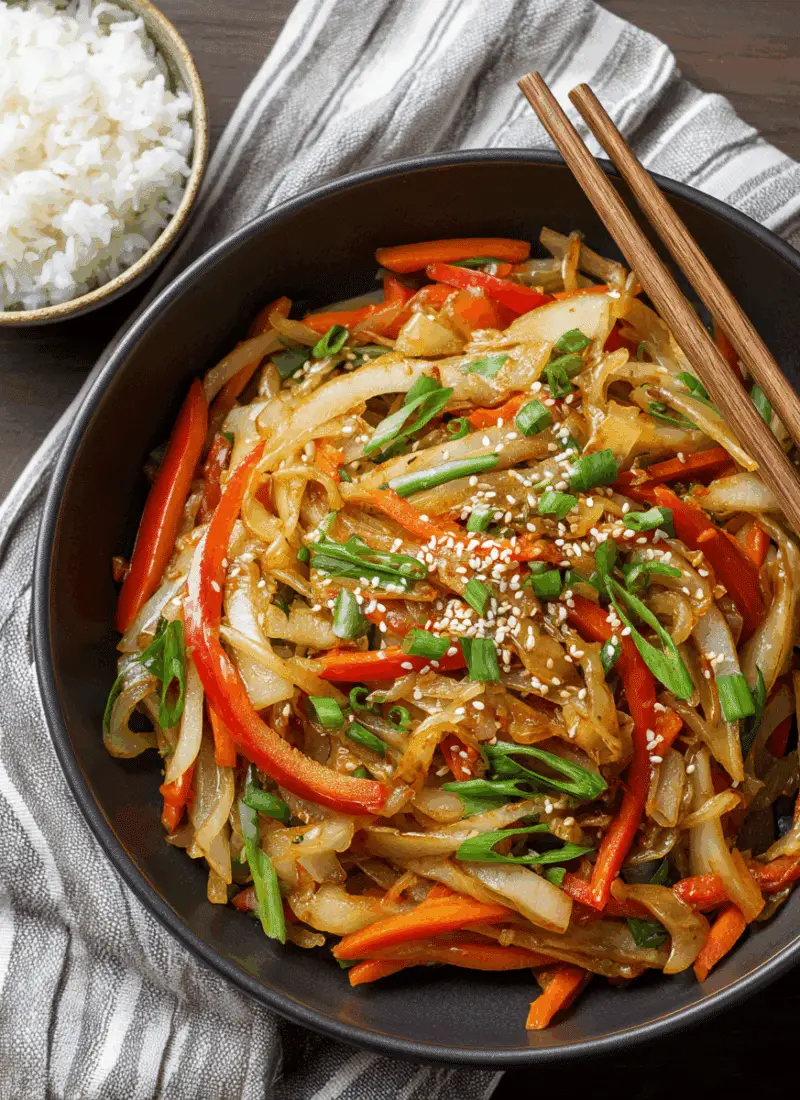This Kohlrabi Stir-Fry is a vibrant, nutrient-packed meal that comes together quickly, making it ideal for weeknight dinners. Kohlrabi, a crisp and mildly sweet vegetable from the cabbage family, takes center stage in this dish. Paired with colorful bell peppers, carrots, and a savory garlic-soy stir-fry sauce, this meal is both healthy and satisfying. Its crunchy texture and ability to absorb bold flavors make kohlrabi an underrated star of stir-fries.
FULL RECIPE
Ingredients
- 2 medium kohlrabi, peeled and julienned
- 1 medium carrot, julienned
- 1 red bell pepper, thinly sliced
- 1 small yellow onion, thinly sliced
- 2 cloves garlic, minced
- 1 tablespoon fresh ginger, grated
- 2 tablespoons soy sauce
- 1 tablespoon sesame oil
- 1 tablespoon vegetable oil
- 1 teaspoon rice vinegar
- 1/2 teaspoon sugar (optional)
- 1/4 teaspoon red pepper flakes (optional for heat)
- 2 green onions, chopped
- 1 tablespoon toasted sesame seeds (for garnish)
- Cooked rice or noodles (for serving, optional)
Directions
- Prepare all vegetables ahead of time by peeling and slicing the kohlrabi, carrot, bell pepper, and onion. Mince the garlic and grate the ginger.
- Heat the vegetable oil in a large skillet or wok over medium-high heat. Once hot, add the onion and sauté for about 1 minute until slightly softened.
- Add the garlic and ginger and stir-fry for another 30 seconds until fragrant.
- Toss in the kohlrabi and carrot. Stir-fry for 3–4 minutes, allowing the vegetables to slightly soften but retain some crunch.
- Add the bell pepper and cook for another 2 minutes, stirring frequently to prevent burning.
- In a small bowl, mix together the soy sauce, sesame oil, rice vinegar, sugar, and red pepper flakes (if using).
- Pour the sauce over the vegetables and stir well to evenly coat. Cook for another 1–2 minutes until the vegetables are glossy and infused with the sauce.
- Remove from heat and sprinkle with chopped green onions and toasted sesame seeds.
- Serve hot over steamed rice or noodles for a complete meal.
Nutrition Facts
Servings: 4
- Calories: 120
- Total Fat: 7g
- Saturated Fat: 1g
- Cholesterol: 0mg
- Sodium: 530mg
- Total Carbohydrates: 13g
- Dietary Fiber: 3g
- Sugars: 5g
- Protein: 2g
- Vitamin A: 80% DV
- Vitamin C: 130% DV
- Calcium: 4% DV
- Iron: 6% DV
Nutritional Benefits of Kohlrabi in Stir-Fries
Kohlrabi is a highly nutritious vegetable that plays a key role in this stir-fry, offering a wide array of vitamins and minerals. Rich in vitamin C, it supports immune function and promotes healthy skin. It’s also a good source of dietary fiber, which aids digestion and helps maintain a healthy gut. With its low calorie content and zero cholesterol, kohlrabi is perfect for weight-conscious diets. In stir-fried dishes, its crunchiness holds up well under heat, preserving many of its nutrients and providing a satisfying texture.
Why Stir-Frying is a Smart Cooking Method
Stir-frying is a quick-cook technique that preserves the flavor, color, and nutritional content of vegetables. The high-heat, short-duration cooking method helps lock in vitamins and minerals that might otherwise be lost through boiling or prolonged heating. It also reduces the need for excessive oil or fat, making it one of the healthiest cooking styles. The speed of stir-frying also makes it ideal for busy home cooks who want to prepare a nutritious, colorful dinner in under 30 minutes.
Flavor Profile of Kohlrabi Stir-Fry
The flavor of this dish is a balanced combination of savory, slightly sweet, and mildly spicy. Kohlrabi itself has a mild, cabbage-like taste with a subtle hint of sweetness, which makes it incredibly adaptable to various seasonings. The soy sauce adds umami depth, while sesame oil provides a nutty richness. Fresh garlic and ginger bring a sharp, aromatic punch, and optional red pepper flakes introduce a mild kick. This combination of flavors ensures that each bite is both comforting and exciting to the palate.
Customizing with Seasonal Vegetables
One of the best features of a kohlrabi stir-fry is its flexibility. It pairs beautifully with a wide range of other vegetables, allowing you to customize the recipe based on seasonal availability. In summer, you might add zucchini, snap peas, or corn. In winter, broccoli, bok choy, or cabbage make great additions. The key is to maintain a balance between soft and crisp textures, ensuring the stir-fry remains dynamic and satisfying.
Adding Protein for a Complete Meal
To transform this stir-fry into a more protein-rich main course, consider adding tofu, tempeh, shrimp, or thinly sliced chicken or beef. Tofu and tempeh absorb the sauce well and are excellent vegetarian options. Meat or seafood should be cooked first and removed from the pan before stir-frying the vegetables, then added back at the end. This keeps everything perfectly cooked and evenly coated in the flavorful sauce, resulting in a well-rounded, satisfying dish.
Ideal Side Dishes and Pairings
Kohlrabi stir-fry is versatile enough to be served with a variety of accompaniments. Steamed jasmine or brown rice is a classic pairing, offering a neutral base that soaks up the stir-fry sauce. For a low-carb option, cauliflower rice or rice noodles can be used instead. You can also serve it alongside dumplings, spring rolls, or a light miso soup for a more complete Asian-inspired meal. A crisp cucumber salad or pickled vegetables add contrast and brightness.
Storage and Reheating Guidelines
This dish stores well in the refrigerator for up to 3 days when kept in an airtight container. To reheat, simply warm it in a skillet over medium heat with a splash of water or soy sauce to restore moisture. While microwave reheating is also an option, it may soften the vegetables more than desired. For best results, avoid freezing as kohlrabi’s texture may become mushy when thawed. Preparing fresh batches is recommended for maintaining optimal texture and taste.
Presentation Tips for Serving
To elevate the visual appeal of your kohlrabi stir-fry, consider serving it in a shallow bowl topped with toasted sesame seeds and chopped green onions. A garnish of fresh cilantro or thinly sliced red chili can add color and dimension. For added crunch and protein, sprinkle crushed roasted peanuts or cashews over the top. Serving on a colorful ceramic plate or bamboo platter also enhances the dish’s aesthetic, making it suitable for casual dinners or entertaining guests.
Flavor Enhancements and Sauce Variations
The basic sauce can be easily modified to suit different taste preferences. For a tangy twist, add a splash of lime juice or rice vinegar. To bring in a touch of sweetness, try honey or maple syrup instead of sugar. You can also experiment with hoisin sauce, oyster sauce, or even a dash of fish sauce for more depth. For heat lovers, Sriracha, chili paste, or fresh Thai chilies can be incorporated. These small tweaks allow you to customize the flavor while keeping the dish grounded in its original character.
Making It Gluten-Free or Vegan
This recipe is naturally vegan when using plant-based oils and no animal products. To ensure it’s gluten-free, simply use tamari or gluten-free soy sauce instead of traditional soy sauce. All the other ingredients, including kohlrabi and the vegetables, are gluten-free by nature. This makes the stir-fry a fantastic option for those with dietary restrictions, as it doesn’t sacrifice flavor or satisfaction while being inclusive of multiple dietary needs.
Conclusion
Kohlrabi stir-fry is a quick, colorful, and nutrient-dense meal that celebrates the natural flavors of vegetables while offering plenty of room for customization. Its balance of texture, aroma, and savory taste makes it appealing to both seasoned cooks and beginners. Whether you’re looking for a vegetarian dinner, a healthy side dish, or a flexible base for other proteins, this stir-fry delivers. With its easy preparation, vibrant presentation, and numerous health benefits, it’s a dish worth adding to your regular meal rotation.







